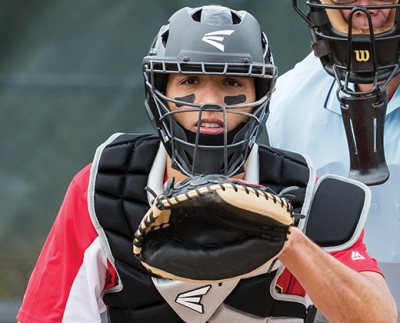
The role of catchers (think wicket-keepers in cricket) in baseball is unenviable. Standing behind the home plate to catch live pitching (think bowling in cricket without a run-up), it is almost unthinkable to take this place without protective gear.
And yet, that was how things were when the sport was still in its infancy. Agreed, pitchers those days were still some way from clocking 100 mph, but it definitely still hurt very much when the catchers became the targets for foul balls and bad bounces.
Despite positioning themselves well behind the striker (think batter in cricket), catchers often copped it on their face and chest. Even when they caught it cleanly, their fingers were often bruised. Put together, it meant that the average career expectancy of a catcher was only three to four seasons. Naturally, it wasn’t much sought after.
Jim “Deacon” White, one of the early stars in the first decades of the sport’s professional era, had other ideas. A star catcher of the Boston Red Stockings in the mid-1870s, White insisted on taking a position closer to the striker behind the plate.
While it did give him an edge to throw out batters and provided the pitcher with a better target, it increased the risk involved tremendously. Even though other catchers tried to avoid it for starters, the advantages of a close-up backstop soon overwhelmed the risks. After this position became the norm in professional circles, it slowly spilled over to colleges as well.
It was under these circumstances that the catcher’s mask came to be. Harvard suddenly found themselves a catcher short at the start of the 1877 season after their previous catcher, Howard K. Thatcher, left the college. Frederick Winthrop Thayer, their coach, decided to bring James Alexander Tyng to that position from the outfield, sensing that Tyng’s quick reflexes and strong throwing arm would make him a perfect fit.
Uncomfortable in his new role as a catcher
Tyng played a few games in the position and got hit by quite a few blows. Thayer couldn’t fail but notice that his new catcher wasn’t really comfortable about his new role and decided that he could solve the problem.
Taking inspiration from a fencing mask, Thayer had a Cambridge tinsmith make a mask. He replaced the wire-mesh design of the fencing mask with a bird-cage like structure and also added a forehead pad and a chin rest for good measure. Wearing it therefore meant that even if there was an impact, the catcher was sufficiently protected.
Mask makes its debut
After trying it out and practicing with it over the winter workouts, Tyng finally put it to the real test in a game in 1877. While the match itself was rather one-sided, it is now remembered as the one in which the catcher’s mask made its debut. Interestingly, Tyng made only two errors behind the plate, an unusually low number during that time. The catcher’s mask was given its due credit as it not only protected Tyng, but also gave him the extra confidence for doing what he did.
The catcher’s mask didn’t catch on immediately and there was in fact more criticism, with some even claiming that the innovation detracted some of the charm from the game. It didn’t do any good that White tried it out during a Boston game and threw it in disgust after a few pitches, claiming it obstructed his view.
Tyng continued to employ the mask and Thayer claimed the invention, applying for a “Improvement in masks” patent early in 1878 and receiving it on February 12 the same year. Before long, amateurs and professionals alike began to realise the convenience and safety that these masks offered. The fact that it also bettered the game by reducing the number of errors that a catcher made was the final push for adoption. So much so that we will be having to travel back in time if we wish to witness a catcher playing without his mask.
Who invented it anyway?
While Thayer does hold the patent to the catcher’s mask and is therefore legally the inventor, there are contradicting claims that it could be Thayer, Tyng or even Thatcher who originally had the idea.
Thatcher claimed that he had used a mask made from heavy wire in 1876 and that he was helped by Thayer to make it.
Tyng claims that he was the one who originally suggested the idea to Thayer, who then had it made using a tinsmith.
Warren R. Briggs, a local catcher, claimed in the press that he had seen an early version of the mask in Thayer’s room in 1875. Briggs even added that he suggested improvements and used the mask in 1876.
Picture Credit : Google




